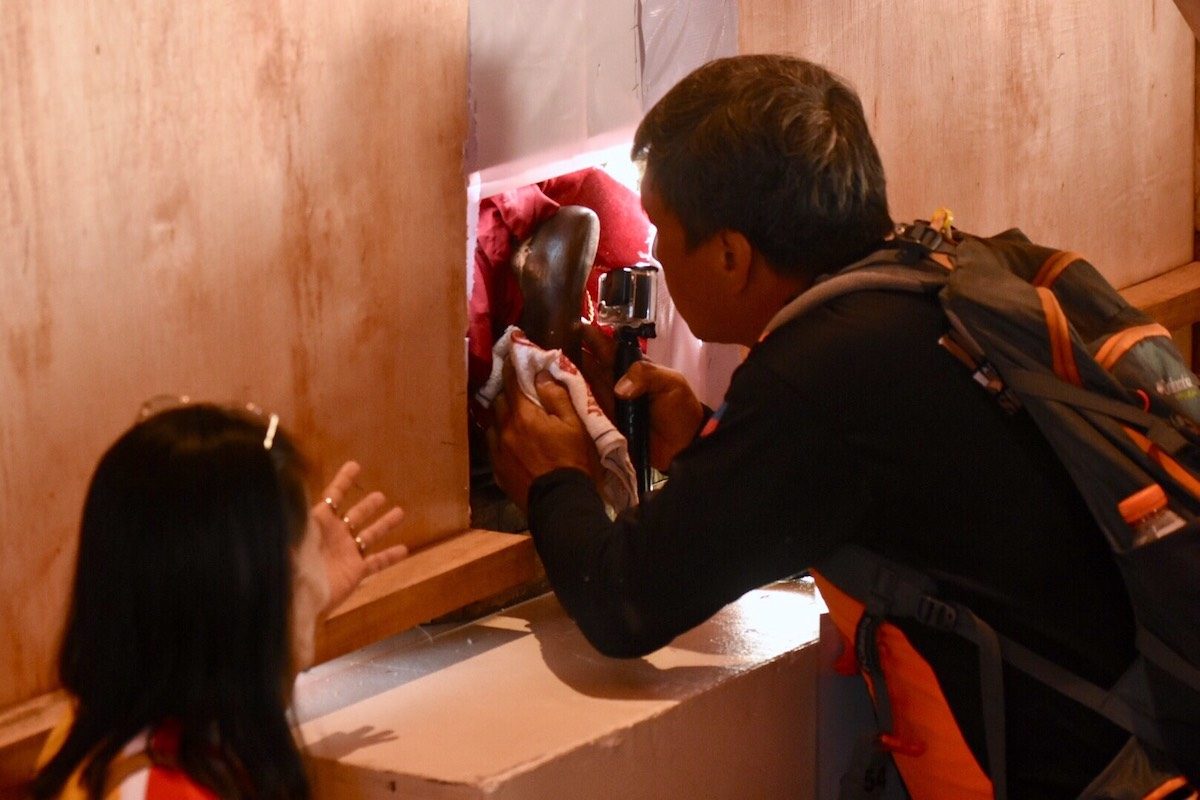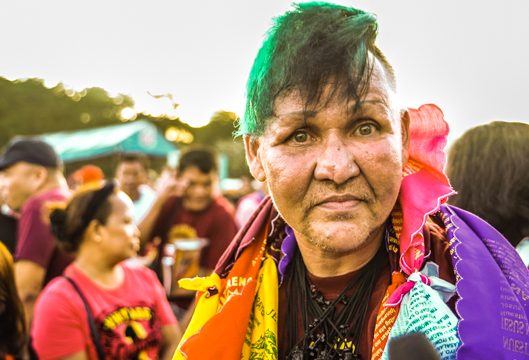SUMMARY
This is AI generated summarization, which may have errors. For context, always refer to the full article.

MANILA, Philippines – Touch, perhaps, is the most central experience in the Feast of the Black Nazarene.
Millions every year attempt touch the image of a dark-skinned Jesus Christ, brought from the Quirino Grandstand to Quiapo Church in downtown Manila. It is an exhausting pilgrimage, leaving authorities to care each year for devotees who faint because of the heat and the crowds.
But there’s another way of reaching the image, as other believers have learned, a path that’s less crowded, less exhausting, and far safer than joining the procession: the Pahalik.
It is a tradition that requires the devotees’ patience, with some camping out for over 20 hours in Luneta Park to secure a spot in a line leading to the image.
It consists of at least two things: waiting in line with a prayer, then literally planting it through a kiss on or touch of the dark-skinned image of Jesus Christ.
“Itong gagawing Pahalik ay isang tradisyon at kultura ng mga hindi lamang ng mga Katoliko lalo’t higit ng mga deboto ng Nazareno, na gusto nilang nahahawakan ang Diyos,” Quiapo Church Vicar Douglas Badong told Rappler in an interview on January 8, when the image was opened for public visitation a day before the popular procession.
(This Pahalik is a tradition and part of a culture not only of Catholics and especially devotees of the Nazarene who want to touch the Lord.)
According to Badong, the image is always open for touching from visitors all year round, but January 8 is a special day as it directly precedes the day of the feast.
It is so special or “holy” in fact, that people fall in line longer than 24 hours before the image is made available to them to touch. Like the believers who struggle to climb the image on January 9, people who wait and get a touch or kiss have stories of miracles of their own.
Early comers

Among the first in the thousands-long lines of devotees was Arnel Sagada, a believer from Trece Martires, Cavite. He came on January 7 at 4 am and had waited for 28 hours before he was able to kiss the wooden statue.
Sagada first went to the Pahalik 13 years ago, during one of the lowest points of his life. He lost his parents and his job in 2004 and had no one to turn to.
He found refuge within the cemented walls of Quiapo Church, devoted himself to the Black Nazarene, and quickly recovered from the crisis. Besides helping him stand again, the visit in 2005 brought him blessings up until the present.
“Mahigit 24 hours na, pero okay lang, hindi kami nagsisisi, hindi kami napapagod kasi nandyan din ang pagsuporta sa amin ng Poong Nazareno (I have been here for more than 24 hours, but it’s okay, we do not regret anything because the Holy Nazarene has supported us),” he said.
Friends in faith
A few people ahead of Sagada were Richard Songalia and Tess San Agustin, friends whose bond was strengthened by their waiting in line to touch the image. They met in 2017.
“Meron kaming samahan sa Pahalik Nazareno (We have an organization for the Pahalik for the Nazarene),” said a proud San Agustin, pointing to people wearing maroon-colored shirts painted with the same design as hers.
San Agustin visited earlier, participating in the Pahalik ever since she was 7 years old. She was brought by her parents, who could not take her with them to the more chaotic procession, she said.
Now she has two kids of her own – the answer to her prayers from years of waiting to touch and kiss the image.

Songalia, on the other hand, became a believer when a wish came true after he went home to Caloocan City after working abroad for 5 years.
“Nagstart po ako 1992, ang hiningi ko po ng awa, bigyan niya po ako ng lakas ng katawan, tibay ng pag-iisip, linisin niya ang aking puso para matuto ako na magmahal ng kapwa ko,” he said.
(I started in 1992, I asked for strength in body and mind, and a clean heart to let me love my neighbors.)
About 26 years later, he waited for over 20 hours, and found acquaintances along the way.
Late yet hopeful
31-year-old Pasay resident Gio Elano was already late. He came at 7 am and stood at the end of the line of devotees slithering from the Quirino Grandstand to the giant Philippine flagpole along Roxas Boulevard.
“Late na nga ako eh. Dapat nga 5 am. Ganyan kasi, ganyan yung punta ko talaga. Galing ako ng work after shift, tapos 6 am diretso ako dito (I’m actually already late. I should’ve arrived at 5 am, my usual arrival time. It’s because I came from work before I came here at 6 am),” he said, explaining that he works at a call center.
He started to line up for the Pahalik out of necessity, he said. He wanted to join a procession years before but was unable to hold on to the ropes that led to the image. There were simply too many people who competed for a grip.
“No’ng una, hindi ako naniniwala, pero tinry ko. Once, nag-wish ako so natupad siya and every year mostly thank you na lang (At first, I did not believe it, but I tried. Once, I wished and it came true and it’s mostly thank yous after that),” he said.
Asked what his granted prayer was, Elano said he simply asked for a stable job and happiness for him and his siblings – prayers already answered.
With patience comes grace

Given that the Pahalik requires less effort, it’s easy to dismiss the tradition as a lesser version of joining the crawling march from Quiapo Church to the Quirino Grandstand.
Father Badong warned believers against thinking of their devotion this way.
“Isang grasya na ang matuto kang maghintay, nagtiis ka (It’s already grace that you learned to wait, that you endured),” Badong said, pointing to devotees like Sagada, Songalia, San Agustin, and Elano who waited for hours and will continue to wait for hours in the name of their faith.
While the Pahalik is less tiring, the wait can get exhausting too. Some devotees back out of the wait mid-way out of impatience or exhaustion.
“So sa bawa’t naghihintay, may kapalit na gantimpala (So each one who waits, receives something in return),” Badong added.
As done every year, the image of the Black Nazarene will be left open to the public until the early hours of January 9, when the tame Pahalik lines turn to a raging sea of people once the procession begins. – Rappler.com
Add a comment
How does this make you feel?
There are no comments yet. Add your comment to start the conversation.